Terrassa
Terrassa (Catalan pronunciation: [təˈrasə], Spanish: Tarrasa) is a city in the east central region of Catalonia, in the province of Barcelona, comarca of Vallès Occidental, of which it is the cocapital along with Sabadell. The name "Terrassa" may well be a contraction/corruption of late Latin: 'terra ix ipsa' -> proto-aragonese 'terra-iš-sa' (Eng: 'that avian/'cool' place') potentially conflated with 'terra-ès-sà' "safe-place/clean-place".
Terrassa
| |
|---|---|
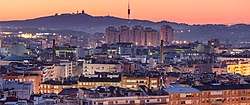 Terrassa | |
 Flag 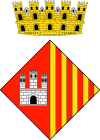 Coat of arms | |
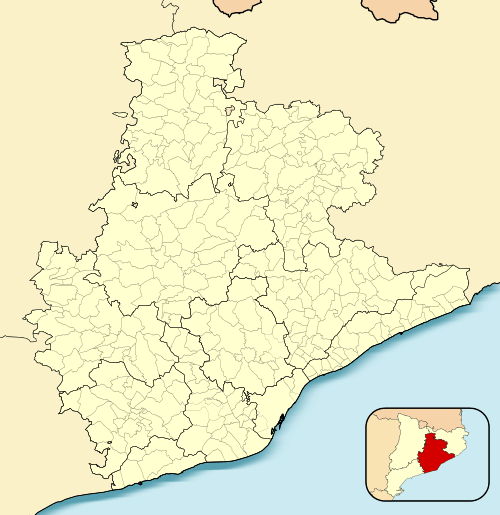 Terrassa Location in Catalonia  Terrassa Terrassa (Spain) | |
| Coordinates: 41.570°N 2.013°E | |
| Country | |
| Autonomous community | |
| Province | Barcelona |
| Comarca | Vallès Occidental |
| Government | |
| • Mayor | Jordi Ballart (TxT) |
| Area | |
| • Total | 70.2 km2 (27.1 sq mi) |
| Elevation | 286 m (938 ft) |
| Population (2018)[2] | |
| • Total | 218,535 |
| • Density | 3,100/km2 (8,100/sq mi) |
| Demonym(s) | Egarencs (Catalan) |
| Time zone | UTC+1 (CET) |
| • Summer (DST) | UTC+2 (CEST) |
| Postal code | 08221 a 08229 |
| Official language(s) | Spanish and Catalan |
| Climate | Cfa |
| Website | www |
It is the site of Roman Egara, a former Visigothic bishopric, which became a Latin Catholic titular see. Since 2004, it is again the see of a bishopric.
The city is located in the Catalan Prelitoral depression (Depressió Prelitoral), at the feet of the Prelitoral mountain range (Natural reserve of Sant Llorenç del Munt) and the average altitude of the city is 277 meters above sea level. It is 20 and 18 kilometres from Barcelona and Montserrat respectively.
Terrassa is the third largest city in Catalonia, after Barcelona and L’Hospitalet.
History
The remains that have been found indicate that the area where Terrassa stands has been inhabited since prehistory. In 2005, during the construction of a tunnel for one of the city's railway lines, a prehistoric site was found in the Park of Vallparadís , with stone tools and fossils of hunted animals dating back 800,000 to 1,000,000 years, making this one of the oldest prehistoric sites in Europe.
Terrassa originated as the Roman town of Egara (Municipium Flavium Egara), which was founded during the time of the emperor Vespasian (69-79 CE), alongside the torrent of Vallparadís (nowadays an urban park) close to the Iberian town of Egosa, on the site of which some ceramics and coins have been found.
Other important remains from the Middle Ages are the former cathedral, the castle of Vallparadís (from 1344 to 1413 a Carthusian monastery and today a municipal museum) and the tower of the castle-palace of the count-king.
In the 19th century the city played an important role in the industrial revolution, specializing in woollen fabrics, and today there is a major Modernista legacy as a result of the city's importance at that time. Particularly notable Modernista buildings include the Masia Freixa (1907), the Vapor Aymerich, Amat i Jover textile mill (1907) (now the Museum of Science and Industry of Catalonia), the Principal theater (1920), the city hall (1902), the Alegre de Sagrera house/museum (1911), the Industrial School (1904), the Gran Casino (1920), the Parc de Desinfecció (1920), and the Independència market (1908). Terrassa is a partner city of the Art nouveau network , a European network of co-operation created in 1999 for the study, preservation and development of Art Nouveau.
Catastrophes
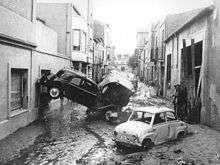
On 25 September 1962, after a long dry season, between 212 and 252 litres of rain per square metre fell in three hours. It caused the rivers Llobregat and Besòs and their tributaries to overflow, creating a water avenue that caused 700 victims and heavy material losses.
The Vallès Occidental comarca was the most damaged. In particularly Terrassa, with 327 victims. The reason of these numbers was that building was permitted around two dry streams used to bring rain water to the Llobregat river. They met in a wedge shape and were not properly channelized. When the streams overflowed it created what was called "the dead triangle", with more than a hundred victims only in the Ègara neighbourhood.[3]
Ecclesiastical history
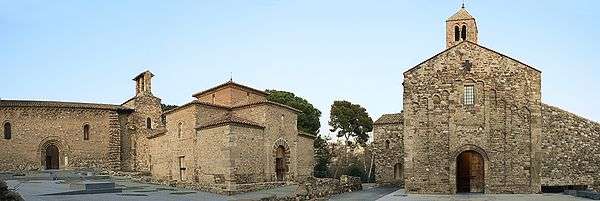
The episcopal see of Ègara already existed by about 450 CE, when it was established on territory split off from the Roman Catholic Diocese of Barcelona, under the Metropolitan Archdiocese of Tarragona. Pope Hilarius confirmed its autonomy be denying a request around 469 to unite it with the Barcelona under its own first bishop, Ireneus.
It comprised parts of these Comarques of Catalonia (Catalan districts) : Alt Penedès, Anoia, Baix Llobregat, Vallès Occidental and Vallès Oriental. A Provincial Council of Tarragona was held there in 615.
It effectively succumbed to the Arab (Muslim) conquest in the 8th century and was probably suppressed, its territory being (rather nominally) returned to the Diocese of Barcelona. The Marian cathedral continued to exist until 718, when it was taken over during the Umayyad conquest of Hispania, but was rebuilt in the 12th century, and remains part of a monumental complex of ancient Visigothic-Romanesque churches of Sant Pere de Terrassa and Sant Miquel on the site.
After the Catholic Reconquista of the region in the tenth century, the see was not restored, its territory being incorporated in the (mother) diocese of Barcelona. Why a request to restore the bishopric by its Metropolitan of Tarragona, Cesareo, wasn't honored by Pope John XII (955-964) is unclear.
On 2004, Pope John Paul II created the new Diocese of Terrassa as a segregation from the Archdiocese of Barcelona. Its seat is the Cathedral of Holy Sprit and Josep Àngel Sáiz Meneses is the current bishop.
Episcopal Ordinaries
- Suffragan Bishops of Egara
- Ireneo (450? – death 465)
- Saint Nebridio (516? – 527?), who was possibly transferred to Barcelona, which had a homonym incumbent in 540. [4]
- Tauro (546? – ?)
- Sofronio (589? – 592?)
- Ilergio (594? – 610?)
- Eugenio (633? – ?)
- Vincenzo (653? – ?)
- Giovanni (683? – 693?)
- Bishops of Terrassa
- Josep Àngel Saiz Meneses (2014.06.05 - current)
Titular see
In 1969 the diocese was nominally restored as Titular bishopric of Egara.
It has had the following incumbents, so far of the fitting episcopal (lowest) rank:
- Justo Goizueta Gridilla, O.A.R. (1970.01.14 – retired 1978.02.15), as Bishop-Prelate of Territorial Prelature of Madera (Mexico) (1970.01.14 – 1988.02.02), previously Apostolic Administrator of same Madera (1967 – 1970.01.14); died 1991
- Juan Francisco Sarasti Jaramillo, C.I.M. (1978.03.08 – 1983.12.23) as Auxiliary Bishop of Roman Catholic Archdiocese of Cali (Colombia) (1978.03.08 – 1983.12.23); later Bishop of Barrancabermeja (Colombia) (1983.12.23 – 1993.03.25), Metropolitan Archbishop of Ibagué (Colombia) (1993.03.25 – 2002.08.17), Metropolitan Archbishop of above Cali (2002.08.17 – retired 2011.05.18) and Apostolic Administrator of Buenaventura (Colombia) (2004.02.21 – 2004.04.29)
- Paulius Antanas Baltakis, O.F.M. (1984.06.01 – 2019.05.17), no prelature so far
- Luis Miguel Romero Fernández, M. Id. (2020.03.20 - current), Auxiliary Bishop of Rockville Centre, New York, USA
Notable Sites
The churches of Sant Pere (Saint Peter)
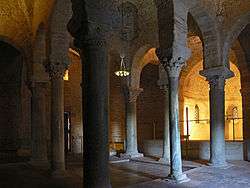
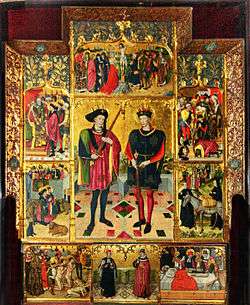
These three churches were built close to the site of old Ègara to be the seat of the Ègara Diocese, which was founded around 450 CE and remained in existence until the 8th century. This episcopal complex follows the Byzantine model of antiquity, with two churches (Sant Pere and Santa Maria) and a mausoleum (Sant Miquel). After a long period of construction, the churches were finished in the then-current manner about the 11th and 12th centuries and in Romanesque style, on the site of the pre-Romanesque buildings of the Visigothic period. The church of Santa Maria contains outstanding works of art, and there are murals dating from the Romanesque period to the Gothic. There is also an altar stone dating from the 10th century and medieval and Romanesque tombstones (one of which documents the name of the Roman town of Egara). In the transept there are three Gothic altarpieces.
- Santa Maria (Saint Mary) the old Cathedral
- Sant Pere (Saint Peter)
- Transept and apse from 9th to 10th centuries
- Nave from the 12th century
- Mosaic from the 10th century (geometric designs)
- Stone altarpiece of Sant Pere from the 10th century
- Gothic frescoes from the 13th century
- Sant Miquel (Saint Michael)
- The Greek cross plan and the walls are the originals from the 6th century
- Frescoes from the 7th and 8th centuries in the apse
- Other items
- Altarpiece of Sant Pere (1411) by Lluís Borrassà
- Altarpiece of Roser (1587)
- Altarpiece of Sant Ruf (17th century)
- Altarpiece of Sant Miquel (1450–51) by Jaume Cirera and Guillem Talarn
- Gothic altarpiece of Sant Abdó i Sant Senén (1460) by Jaume Huguet
- Polychrome sculpture of Saint Mary from the 14th century
Other
The city is heir to a rich medieval, Modernista and industrial legacy, and possesses an extensive network of libraries, historical archives and museums.
- The museum of Terrassa, municipally-owned, has various sections:
- Castle/Charterhouse of Vallparadís, in the Park of Vallparadís
- Visigothic-Romanesque churches of Sant Pere (Saint Peter)
- Casa Alegre de Sagrera, Modernista house in Carrer Font Vella
- Tower of the Palau, the only vestige of the castle-palace of the count-kings of Catalonia in Terrassa
- Center of medieval interpretation of the city of Terrassa
- Convent of Sant Francesc, cloister decorated with polychromed ceramics (1671-1673)
- Museum of Science and Industry of Catalonia, in the former Aymerich Amat i Jover mill, managed by the Generalitat de Catalunya
Municipal Government
The Municipal Council has 27 seats and according to the result of the local elections of May 2019 is formed by:
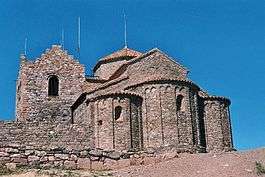
- All for Terrassa (Tot per Terrassa, TxT) - 10 seats (29.28%)
- Socialists' Party of Catalonia (Partit dels Socialistes de Catalunya, PSC) - 7 seats (20.55%)
- Republican Left of Catalonia (Esquerra Republicana de Catalunya, ERC) - 5 seats (14.93%)
- Citizens (Ciutadans, Cs) - 3 seats (8.11%)
- Together for Catalonia (Junts per Catalunya, JxCAT) - 2 seats (7.56%)
The municipal government is formed by a coalition of Tot per Terrassa and ERC.[5] The Mayor is Jordi Ballart (TxT).
Transportation
Terrassa is well connected with Barcelona's port and airport by highway and railway. The C-58 and C-16 also link the city with (Manresa), (Girona, France), and (Tarragona).
The railway reached Terrassa in 1856, and nowadays two lines serve the city. The first, operated by RENFE, connects with Barcelona and Lleida, and the second, operated by FGC, with Barcelona. Recently FGC extended its line to the north of the city, building three new stations; one of them acts as a rail hub with the RENFE line. This extension is known as the Terrassa Metro.
Several interurban bus lines connect Terrassa with the closest cities and towns such as Sabadell, Castellar del Vallès, Martorell, Rubí, Sant Cugat del Vallès and Vacarisses.
Transport inside the city is provided by 14 bus lines operated by a municipal company (Transports Municipals d'Ègara). In the future, when the three new FGC stations and the two planned for the RENFE line are in use, the railway will also serve as urban transport.
Culture
Music and theater
A lot of musicians and actors are based in Terrassa because of the large number of music schools, a long amateur theater tradition and the local seat of the University of Drama. Since 1982, the Terrassa Jazz Festival has been especially outstanding, with guests like Stan Getz, Chet Baker, Dexter Gordon, Tete Montoliu, Dizzy Gillespie. Local bands such as Doctor Prats have also developed a national and international following.[6]
Mass media
Terrasa has a local newspaper, the Diari de Terrassa, that is published daily from Tuesday to Saturday, as well as several radio stations: Ràdio Terrassa/Cadena SER Vallès on 828 AM and 89.4 FM, with more than 75 years of history behind it, being one of the pioneering radio stations in Catalonia and Spain; the municipal radio (Noucincpuntdos, 95.2 FM); and Radio Star de Terrassa, the city's cultural station, on 100.5 FM, which was founded in 1984 and is one of the historic local radios of Catalonia.
Also, the city has several local channels - TV20 Locàlia Vallès and Canal Terrassa, with an audience of more than 50,000 viewers. In addition, there is the free newspaper Terrassa Societat, published monthly with a circulation of 50,000, and Terrassa Month, published of Monday through Friday and also covering local events. Since 2005 the municipal digital newspaper e-newsterrassa.com, in Catalan, has been on line (as for 2013, this digital newspaper has been taken down). The municipal Web site www.terrassa.cat receives no fewer than 150,000 monthly visitors.
As for 2013, current and working digital newspaper in Terrassa is Diari de Terrassa i Catalunya InfoTalQual.com
There's a new media, free magazine called La Veu de Terrassa owned by El Grup la veu.
Sports
Terrassa was a pioneer in the introduction of field hockey and korfball in Catalonia and played an important role in the introduction of basketball. The most important sport in the city is field hockey. During the Barcelona Olympic Games in 1992, Terrassa was the city where the field hockey competition was played. The great number of hockey players from Terrassa who have participated in the Olympic Games over the years has led to Terrassa's being referred to as the "most Olympic city in the world". Between 1928 and 2004, Terrassa sent 124 athletes to the Olympic Games, the majority of whom were hockey players. Three local field hockey clubs, Atlètic Terrassa, Club Egara and Club Deportiu Terrassa have all won the División de Honor de Hockey Hierba and the Copa del Rey de Hockey Hierba. Atlètic Terrassa and Club Egara have also won the EuroHockey Club Champions Cup.
Other local sports teams include CN Terrassa (water polo), Terrassa FC (association football) and Sferic Terrassa (basketball).
Terrassa is the home and birthplace of FC Barcelona and Spain national football team midfielder Xavi.
The city's castells teams are the Minyons de Terrassa and the Castellers de Terrassa. On November 22, 2015, Terrassa's Plaça Vella was the scene of the world's first successful 4 de 10 amb folre i manilles, completed by the Minyons.[7]
Twin towns
Terrassa is twinned with five cities:[8]
Terrassa also signed a protocol of special relations cooperation with:
See also
- School of Engineering of Terrassa
- List of Catholic dioceses in Spain, Andorra, Ceuta and Gibraltar
References
- "El municipi en xifres: Terrassa". Statistical Institute of Catalonia. Retrieved 23 November 2015.
- Municipal Register of Spain 2018. National Statistics Institute.
- "Riuades 1962" (in Catalan). 4 March 2012. Retrieved 13 July 2016.
- A. Lambert, lemma 'Barcelone', in Dictionnaire d'Histoire et de Géographie ecclésiastiques, vol. VI, 1932, col. 676.
- "TxT i ERC-MES presenten un programa de govern amb la vista posada al 2030". Canal Terrassa (in Catalan). Retrieved 5 November 2019.
- "Els terrassencs Doctor Prats fan el seu primer concert en directe a Faktoria" [The Terrassan group Doctor Prats give their first live concert in Faktoria], terrassadigital.cat (in Catalan)
- Martín, Carol (12 November 2015). "Els Minyons de Terrassa fan història en descarregar el quatre de deu amb folre i manilles". Ara. Retrieved 22 November 2015.
- "Hermanamientos". Ajuntament de Terrassa. Retrieved 26 January 2020.
Sources and external links
| Wikimedia Commons has media related to Terrassa. |
- Bibliography - ecclesiastical history
- D. Mansilla, lemma 'Egara' in Dictionnaire d'Histoire et de Géographie ecclésiastiques, vol. XIV, Paris 1960, coll. 1462-1466
.svg.png)